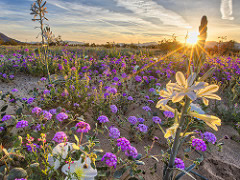BLM to consider changes to Desert Renewable Energy Conservation Plan
Organization:
BLM Office:
Media Contact:
 SACRAMENTO, Calif. – In response to President Trump’s order to review regulations that unnecessarily impede energy development, the Bureau of Land Management announced today that it will consider amending the Desert Renewable Energy Conservation Plan (DRECP) to seek greater opportunities for renewable energy generation.
SACRAMENTO, Calif. – In response to President Trump’s order to review regulations that unnecessarily impede energy development, the Bureau of Land Management announced today that it will consider amending the Desert Renewable Energy Conservation Plan (DRECP) to seek greater opportunities for renewable energy generation.
The BLM will publish a Federal Register notice this week to open a 45-day public comment period on the Desert Renewable Energy Plan (DRECP), which covers about 10.8 million acres of BLM-managed public land. On September 14, 2016, the BLM issued the Record of Decision for the DRECP, which made only 7 percent of the area available for renewable energy leasing.
“We need to reduce burdens on all domestic energy development, including solar, wind and other renewables,” said Principal Deputy Assistant Secretary for Land and Minerals Katharine MacGregor. “This process will help us find ways to make more federal land available for renewable energy projects as well as wireless broadband infrastructure.”
President’s Trump Executive Order 13783, “Promoting Energy Independence and Economic Growth,” directs agencies to review all actions that could “potentially burden the development or use of domestically produced energy sources.” A second Executive Order called “Streamlining and Expediting Requests to Locate Broadband Facilities in Rural America” directs Federal agencies “…to reduce barriers to capital investment [and] remove obstacles to broadband services” in order to foster rural broadband.
In California, Gov. Arnold Schwarzenegger signed an order in 2008 requiring 33 percent of California’s energy production to come from renewable sources by 2020. More recently, Gov. Jerry Brown Jr. signed into law a measure requiring retail sellers and publicly owned utilities to get 50 percent of their energy from renewable sources by 2030.
Renewable energy associations and local governments expressed concerns to the Department of the Interior that the DRECP did not designate enough public lands for future renewable energy development. Furthermore, the Riverside County Board of Supervisors and the Blythe Council said the regulatory burdens created by the DRECP would make projects too costly to build, put undue pressure on private lands, and inhibit economic growth and job creation. These entities recommended a more efficient, streamlined and balanced approach to renewable energy development on both public and private lands.
The comments sought in this new Federal Register notice will be used to help set the parameters, or scope, of the review of the Desert Renewable Energy Conservation Plan (DRECP). In particular, the notice asks for comments on how land designations identified in the plan might affect development of solar, wind or other renewable energy resources.
The entire DRECP planning area covers approximately 22.6 million acres of both federal and non-federal land in seven counties: Imperial, Inyo, Kern, Los Angeles, Riverside, San Bernardino and San Diego. The Federal Register notice specifies that the BLM will consider amendments to the California Desert Conservation Area, the Bakersfield Resource Management Plan, and the Bishop Resource Management Plan.
Comments should be sent to the BLM-California State Director, 2800 Cottage Way, Rm W-1623, Sacramento, CA 95825, or electronically to [email protected]. All comments will be accepted in writing for 45 days after the publication of the notice in the Federal Register or 15 days after the last public meeting, whichever is later. The dates and locations of any scoping meetings will be announced at least 15 days in advance through local news media, newspapers and the BLM website: https://www.blm.gov/california/drecp.
The BLM manages about 245 million acres of public land located primarily in 12 western states, including Alaska, on behalf of the American people. The BLM also administers 700 million acres of sub-surface mineral estate throughout the nation. Our mission is to sustain the health, diversity, and productivity of America’s public lands for the use and enjoyment of present and future generations.
